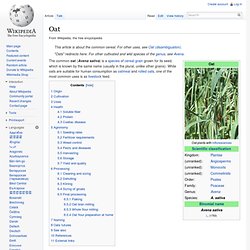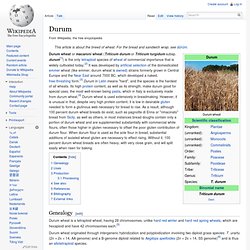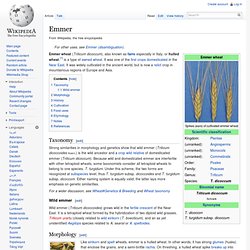

Quinoa. Quinoa (Chenopodium quinoa; (/ˈkiːnwɑː/ or /kɪˈnoʊ.ə/, from Quechua kinwa or kinuwa)[2] is a flowering plant in the amaranth family.

It is a herbaceous annual plant grown as a grain crop primarily for its edible seeds. Quinoa is not a grass, but rather a pseudocereal botanically related to spinach and amaranth (Amaranthus spp.). After harvest, the seeds are processed to remove the bitter-tasting outer seed coat. Quinoa. Buckwheat. Oat. The common oat (Avena sativa) is a species of cereal grain grown for its seed, which is known by the same name (usually in the plural, unlike other grains).

While oats are suitable for human consumption as oatmeal and rolled oats, one of the most common uses is as livestock feed. Origin[edit] The wild ancestor of Avena sativa and the closely related minor crop, A. byzantina, is the hexaploid wild oat A. sterilis. Genetic evidence shows the ancestral forms of A. sterilis grew in the Fertile Crescent of the Near East. Domesticated oats appear relatively late, and far from the Near East, in Bronze Age Europe. Cultivation[edit] Oats are grown in temperate regions. Barley. Barley (Hordeum vulgare L.), a member of the grass family, is a major cereal grain.

It was one of the first cultivated grains and is now grown widely. Rice. A mixture of brown, white, and red indica rice, also containing wild rice, Zizania species Rice is the seed of the grass species Oryza sativa (Asian rice) or Oryza glaberrima (African rice).

As a cereal grain, it is the most widely consumed staple food for a large part of the world's human population, especially in Asia. It is the agricultural commodity with the third-highest worldwide production, after sugarcane and maize, according to 2012 FAOSTAT data.[1] Since a large portion of maize crops are grown for purposes other than human consumption, rice is the most important grain with regard to human nutrition and caloric intake, providing more than one-fifth of the calories consumed worldwide by humans.[2] Cooked brown rice from Bhutan From East Asia, rice was spread to Southeast and South Asia.[6] Rice was introduced to Europe through Western Asia, and to the Americas through European colonization.
Maize. Maize (/ˈmeɪz/ MAYZ; Zea mays subsp. mays, from Spanish: maíz after Taíno mahiz), known in some English-speaking countries as corn, is a large grain plant domesticated by indigenous peoples in Mesoamerica in prehistoric times.

The leafy stalk produces ears which contain the grain, which are seeds called kernels. Maize kernels are often used in cooking as a starch. History A maize heap at the harvest site, India Most historians believe corn was domesticated in the Tehuacan Valley of Mexico.[1] The Olmec and Mayans cultivated it in numerous varieties throughout Mesoamerica, cooked, ground or processed through nixtamalization. Maize is the most widely grown grain crop throughout the Americas,[3] with 332 million metric tons grown annually in the United States alone. Millet. Millets are a group of highly variable small-seeded grasses, widely grown around the world as cereal crops or grains for fodder and human food.

Millets are important crops in the semiarid tropics of Asia and Africa (especially in India, Mali, Nigeria, and Niger), with 97% of millet production in developing countries.[1] The crop is favored due to its productivity and short growing season under dry, high-temperature conditions. Kamut. Khorasan wheat or Oriental wheat (Triticum turgidum ssp. turanicum also called Triticum turanicum) is a tetraploid wheat species.[2] It is an ancient grain type; Khorasan refers to a historical region in modern-day Afghanistan and the northeast of Iran.

This grain is twice the size of modern-day wheat and is known for its rich nutty flavor.[3] Taxonomy[edit] Original botanical identifications were uncertain. The variety is a form of Triticum turgidum subsp. turanicum (also known as Triticum turanicum), usually called Khorasan wheat. Identifications sometimes seen as T. polonicum are incorrect as the variety, although long-grained, lacks the long glumes of this species. Rye. Wheat. Wheat (Triticum spp.)[1] is a cereal grain, originally from the Levant region of the Near East and Ethiopian Highlands, but now cultivated worldwide.

In 2010, world production of wheat was 651 million tons, making it the third most-produced cereal after maize (844 million tons) and rice (672 million tons).[2] Wheat was the second most-produced cereal in 2009; world production in that year was 682 million tons, after maize (817 million tons), and with rice as a close third (679 million tons).[3] This grain is grown on more land area than any other commercial food. History[edit] Wheat is one of the first cereals known to have been domesticated, and wheat's ability to self-pollinate greatly facilitated the selection of many distinct domesticated varieties.
The archaeological record suggests that this first occurred in the regions known as the Fertile Crescent. Durum. Genealogy[edit] Durum wheat is a tetraploid wheat, having 28 chromosomes, unlike hard red winter and hard red spring wheats, which are hexaploid and have 42 chromosomes each.

Durum wheat originated through intergeneric hybridization and polyploidization involving two diploid grass species: T. urartu (2n = 2x = 14, AA genome) and a B-genome diploid related to Aegilops speltoides (2n = 2x = 14, SS genome)[6] and is thus an allotetraploid species. Uses[edit] Commercially produced dry pasta, or pasta secca, is made almost exclusively from durum semolina. Certain home made fresh pastas (pasta fresca), such as orecchiette, cavatelli, and malloreddus, also use durum wheat, while others, such as tagliatelle, use only soft wheat, often "00," or a combination of soft and hard wheats.
Husked but unground, or coarsely ground, it is used to produce the semolina in the couscous of North Africa and the Levant. Another type of pasta, al-fidawsh (called "dry pasta"), was popular in al-Andalus. Einkorn wheat. Emmer. Taxonomy[edit] Strong similarities in morphology and genetics show that wild emmer (Triticum dicoccoides Koern.) is the wild ancestor and a crop wild relative of domesticated emmer (Triticum dicoccum).

Because wild and domesticated emmer are interfertile with other tetraploid wheats, some taxonomists consider all tetraploid wheats to belong to one species, T. turgidum. Under this scheme, the two forms are recognized at subspecies level, thus T. turgidum subsp. dicoccoides and T. turgidum subsp. dicoccom. Either naming system is equally valid; the latter lays more emphasis on genetic similarities. Spelt. Spelt, also known as dinkel wheat,[2] or hulled wheat,[2] is a species of wheat cultivated since the fifth millennium BC.
Spelt was an important staple in parts of Europe from the Bronze Age to medieval times; it now survives as a relict crop in Central Europe and northern Spain and has found a new market as a health food. Spelt is sometimes considered a subspecies of the closely related species common wheat (T. aestivum), in which case its botanical name is considered to be Triticum aestivum subsp. spelta. It is a hexaploid wheat, which means it has six sets of chromosomes. Evolution[edit] Genetic evidence shows that spelt wheat can also arise as the result of hybridisation of bread wheat and emmer wheat, although only at some date following the initial Aegilops-tetraploid wheat hybridisation.